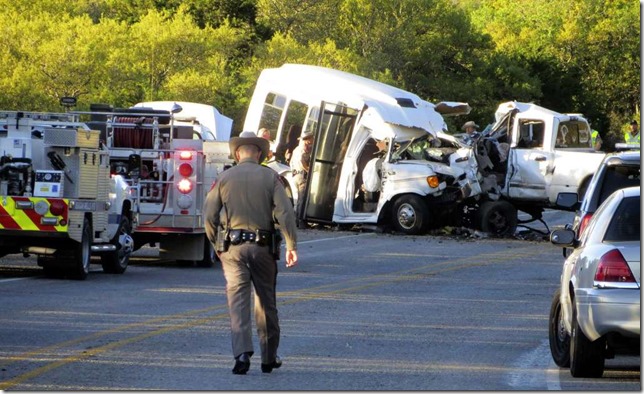"My dad has always had a heart for people,” recalls Jenn Barrett. “I’m glad that he lived a life that mattered.” Jenn was speaking about her father, Murray Barrett. From all reports, Murray had a selfless heart of gold. He served his country as a U.S. Marine pilot and later taught mathematics to middle schoolers . Married for 32 years, Murray and his wife, Dianne, had 4 children.
Yet Murray had a special place in his heart for fatherless boys and mentored several boys as a volunteer in the Big Brother Big Sisters organization. He was dedicated to his faith, sang in the church choir on Sundays and drove the church bus. He was serving in this capacity, driving home a group of church members from a religious retreat, when a 20-year old man in a pick-up struck the bus crossed over into his lane and collided head-on with the bus. Murray and 12 passengers were killed. The 20-year old driver of the pick up truck, who walked away uninjured, told investigators at the accident scene that he was checking his phone for a text when the crash occurred.
 The National Safety Council reports that motor vehicle fatalities increased 14% from 2014 to 2106; distracted driving is suspected to being a major contributor to the increase. This conclusion is supported by data collected by the Texas Dept. of Transportation which found 1 in 5 traffic crashes are caused by distracted driving.
The National Safety Council reports that motor vehicle fatalities increased 14% from 2014 to 2106; distracted driving is suspected to being a major contributor to the increase. This conclusion is supported by data collected by the Texas Dept. of Transportation which found 1 in 5 traffic crashes are caused by distracted driving.
The overwhelming majority of states have laws that prohibit texting-while-driving. The states which still allow texting-while-driving (as of November 2017) are: Arizona, Montana and Missouri (drivers over 21 years old only). Texas only enacted a texting-while-driving ban in September 2017 after the church bus deaths back in March.
California has one of the most restrictive and safest laws regarding driving and mobile phone use in the nation.
Holding Your Phone
Only 14 states prohibit handling of a mobile phone while driving. If you drive in California, you are not allowed to hold your smartphone to talk, even if it’s on speakerphone. You are also prohibited from touching your phone to look up directions, read email, and send text messages. But you can make phone calls or send messages using voice assistance such as Siri on the iPhone or Google’s AI assistant.
Since holding your phone is prohibited, a great option to see the phone display for GPS directions, for example, is to mount your phone on your dashboard, windshield or an air vent. These mounting devices are easy to install and cost as low as $8. California law dictates where you can mount your phone. It can be mounted on the dashboard of your car or in the lower left or lower right corner of your windshield to keep an unobstructed view of the road. Mounting the phone in the middle of the windshield is prohibited because it obstructs your view.
Emergencies and Using Your GPS
California driving laws allow few exceptions to touching your phone while driving. You are allowed a single tap or swipe of your phone to open or activate a GPS app. You can also handle your phone while driving if there is an emergency and you need to dial 911 to call the fire department or police.
Young Drivers
Young drivers in California have even more restrictions. With the exception of an emergency situation, drivers younger than 18 cannot use a mobile phone at all while operating a vehicle. They aren’t allowed to talk on the mobile phone, text with or without voice-assistance, or operate their phone’s GPS.
Wearing Headphones
Drivers commonly use headphones or earbuds with their smartphones to listen to music or make phone calls. But California's driving laws prohibit covering both ears with headphones, earphones or earbuds. (Bicyclists are also prohibited from wearing earbuds in both ears.) An excellent alternative is to connect your smartphone to your car’s audio system via an audio cable or Bluetooth connection. Or you can use a portable Bluetooth speaker in your car or purchase a kit which enables your mobile phone to play music through your car’s audio system.
Fines
Although I personally support the stringent measures of the California distracted drive law, I believe that it lacks teeth. If caught holding a mobile phone, drivers only pay a $20 fine for the first offense and $50 for subsequent offenses. I still see plenty of drivers breaking the law every day by holding their phones while making calls and texting while driving. So I don’t think these fines are strong enough to dissuade drivers from their dangerous behavior.
The California distracted driving law goes a long way to preventing highway deaths, injuries and property damage. Parents should also consider what kind of behavior they are modeling for their children when they text while driving. We certainly don’t want our teenage children texting while driving which could endanger them and the lives of others.
Source: California Vehicle Code


You must be logged in to post a comment.